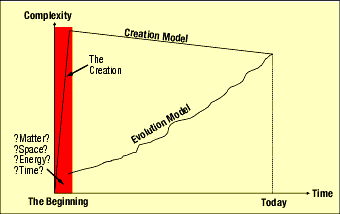Questions and Answers
Q1: Can creation be dealt with scientifically? [See also "How Can the Study of Creation Be Scientific?" on page 438.]
A1: Scientists employ a common but special type of reasoning when they try to explain past, unrepeatable events that had no observers. They first develop a model—or what scientists call a “working hypothesis.” This simply describes what they think happened. Alternate explanations must also be defined. Then, evidence is shown that will raise or lower the plausibility of the various possible explanations. There are many possible models of origins. However, the two basic models, creation and evolution, can be defined as follows:
The Creation Model of Origins:
The Evolution Model of Origins:
Neither creation nor evolution can explain scientifically what happened at the ultimate beginning (represented by the region in red in Figure 253). The evolution model is completely silent about the origin of matter, space, energy, time, and the laws of chemistry and physics. The farthest back in time most evolutionists claim to go is to a hypothetical “big bang.” They admit that they have no scientific understanding of what preceded such an event. Creationists likewise have no scientific understanding of what happened during the creation event. Nevertheless, to the right of the red region, both models can be tested against the evidence. For any assumed starting condition, scientists frequently ask if the laws of physics and chemistry would produce what we see today. These are certainly scientific questions that give us insight into our beginnings.
Q2: How can those high school students who are underachievers or poorly motivated carry out this project?
A2: Teachers who see students having difficulty may choose to limit them to a narrower topic, such as the fossil record. Students could be asked such questions as:
Answers to these questions could form an outline for a student’s paper. If the student requires more guidance, references and page numbers could be included with each question.
Students are often surprised that their conclusions differ from those of some scientists—either creationists or evolutionists. The confidence these students have that their answers are more credible than those of certain scientists will produce self-confidence and an increased interest in science. Students frequently want to explore other aspects of the origins controversy on their own. Generating this sense of excitement and discovery should be an objective of every science curriculum.
Q3: What would the minimum project involve at the high school level?
A3: The following would require only three class periods; they should be spread out over at least three weeks.
Day 1:
- Pass out the assignment sheets that (1) state the length, format, grading criteria, and due dates for the outline and final 1,000-word paper; (2) define “creation” and “evolution”; and (3) list the resources available in the school library.
- Describe selected resources.
- Explain science methodology when dealing with past events that were not observed and cannot be repeated. [See Figure 253.]
Day 2:
Day 3:
